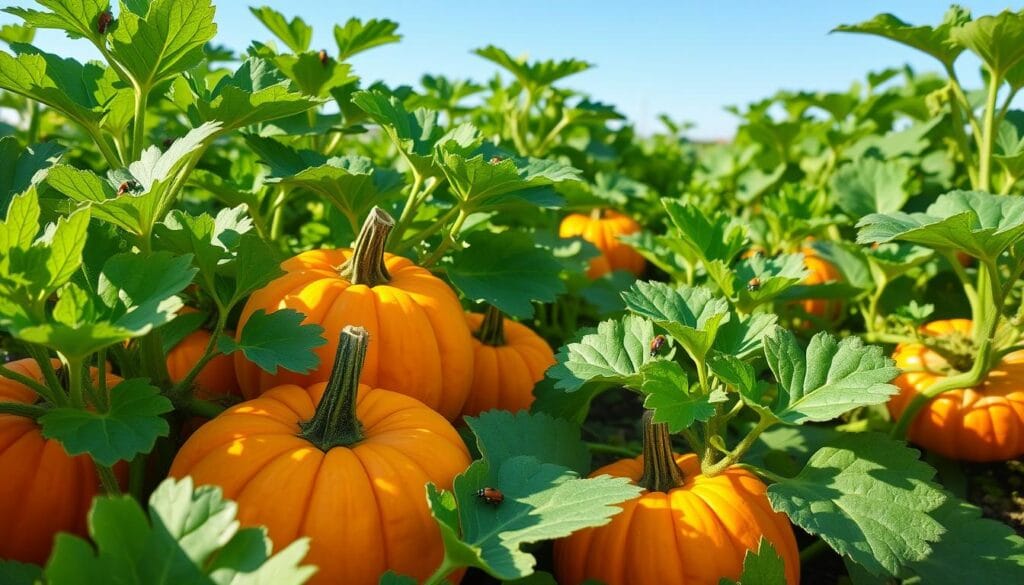Are you ready to grow a thriving pumpkin plant in your backyard? This guide will teach you everything you need to know. You’ll learn how to pick the right variety and care for your plant.
Key Takeaways
- Understand the basics of pumpkin plant varieties, life cycle, and growing requirements.
- Identify the ideal location and prepare the soil for optimal pumpkin growth.
- Learn proper planting techniques and water management strategies for healthy plants.
- Effectively manage pumpkin vines and address common pest and disease issues.
- Discover the perfect timing and methods for harvesting and storing your pumpkins.
Understanding Pumpkin Plant Basics
Pumpkins are a favorite in many home gardens. They add beauty and versatility to the landscape. Knowing the different pumpkin varieties, the plant’s life cycle, and growing needs is key.
Popular Pumpkin Varieties for Home Gardens
Home gardeners have many pumpkin varieties to choose from. Some favorites include:
- Sugar Pie Pumpkins: Smaller, perfect for pies and baking.
- Cinderella Pumpkins: Known as Rouge vif d’Etampes, they have a unique shape and vibrant orange color.
- Jack-o’-Lantern Pumpkins: Ideal for carving and decorating during Halloween.
Life Cycle of a Pumpkin Plant
The pumpkin plant’s life starts with seed germination. It then grows vines, leaves, and flowers. After pollination, the pumpkin grows and matures, reaching its full size and color. Knowing this cycle helps gardeners plan for the best results.
Basic Growing Requirements
Pumpkins need warm, well-drained soil and lots of sunlight. They need consistent moisture, especially when they’re flowering and growing fruit. Good soil preparation, with organic matter, helps a lot.
“Pumpkins are a versatile and rewarding crop for home gardeners, offering both visual appeal and culinary possibilities.”
Selecting the Perfect Growing Location
Choosing the right spot for your pumpkin plant is key to its success. Whether you’re new to gardening or have experience, knowing what makes a pumpkin cultivation thrive is important. It will help you get a great harvest.
Pumpkin plants love lots of sunlight. Look for a spot that gets at least six to eight hours of direct sunlight a day. This helps your pumpkin plant grow strong vines and big, tasty fruits.
Pumpkin plants also need soil that drains well. Stay away from places with too much water, as it can cause root rot. The soil should be rich in organic matter and have a pH between 6.0 and 6.8.
Pumpkin plants need lots of space to spread out. Pick a spot that has at least 50 square feet per plant. Make sure the area is clear of big rocks or tree roots that could block the pumpkin plant’s growth.

By thinking about these things, you can make the best spot for your pumpkin plant. This will help your pumpkin cultivation succeed.
Soil Preparation and Requirements
Getting your soil right is key for growing great pumpkins. Knowing the best soil conditions is crucial for a successful harvest.
Optimal Soil pH Levels
Pumpkins do best in slightly acidic to neutral soil. The ideal pH range is 6.0 to 6.8. Start by testing your soil’s pH level. If it’s too alkaline, adding sulfur can help lower it.
Essential Nutrients for Pumpkins
- Nitrogen (N) for lush foliage growth
- Phosphorus (P) for root and flower development
- Potassium (K) for overall plant vigor and disease resistance
Using a balanced, slow-release fertilizer or compost before planting is a good idea. It gives your pumpkins the nutrients they need to grow well.
Composting Tips for Pumpkin Beds
Adding compost to your pumpkin beds is a smart move. Mix in 2-4 inches of compost to enrich the soil. This makes a great environment for your pumpkin plants.

“Healthy soil is the foundation for a successful pumpkin harvest. Take the time to prepare your beds properly, and you’ll be rewarded with a bountiful crop.”
When and How to Plant Pumpkin Seeds
Planting pumpkin seeds at the right time is key for a good harvest. The best time to plant pumpkin seeds varies by your local climate. Generally, plant them after the last frost, usually in late spring or early summer.
This timing helps the soil warm up for your pumpkin plants to grow well.
For successful pumpkin planting, remember a few important tips:
- Choose a sunny spot in your garden with good drainage.
- Plant the seeds 1 inch deep and 3-4 feet apart for the vines to spread.
- Water the seeds well after planting. Keep the soil moist until they sprout, which takes 7-10 days.
“Gardening is a journey of discovery, and pumpkin planting is a delightful adventure. With the right timing and techniques, you can cultivate a thriving pumpkin patch in your own backyard.”
Be patient and take good care of your pumpkin plant from pumpkin seeds. Follow these steps for a rich pumpkin harvest.

Watering Techniques for Healthy Pumpkin Plants
Getting the right amount of water is key for your pumpkin plants to do well. Whether you’re new to gardening or have experience, knowing how to water is crucial. It can greatly impact your pumpkin crop’s success.
Irrigation Methods
There are several ways to water your pumpkin plants. Drip irrigation systems give water slowly and directly to the roots. This helps prevent waste and encourages deep root growth. Sprinklers can cover the whole patch evenly but might increase disease risk.
Water Requirements by Growth Stage
- Germination and seedling stage: Pumpkin seeds need about 1 inch of water per week. This ensures they germinate well and grow strong.
- Vegetative growth stage: As plants grow, they need 1-2 inches of water per week. The soil should be moist but not too wet.
- Flowering and fruit development: At this stage, plants need 1-2 inches of water per week. This supports the growth of their large fruits.
Signs of Over and Under Watering
It’s important to know when your plants are getting too much or too little water. Yellow or wilted leaves and slow growth mean they’re thirsty. On the other hand, yellow leaves and soggy soil can mean you’re watering too much. This can cause root rot and other problems.
“Proper watering is the foundation for a healthy pumpkin patch. By understanding the unique needs of your plants, you can ensure they thrive throughout their life cycle.”

By using these watering tips, you can create the best environment for your pumpkin plants. This will help them grow well and give you a big harvest.
Managing Pumpkin Vines and Growth
To grow a great pumpkin patch, you need to manage the vines well. Learning how to train, prune, and support the vines helps. This way, you can get more fruit and keep the plants healthy. Knowing what pumpkin vines need is key to a good harvest.
Vine Training and Pruning
It’s important to guide the vines to grow in a certain way. This could be along a trellis or fence. It keeps the vines tidy, improves air and sun, and helps the pumpkins grow better.
Also, cutting back on extra or damaged vines helps. It makes the plant put more energy into growing bigger, healthier pumpkins.
Vine Support Systems
Using a support system keeps the vines from spreading too much. This stops them from damaging the pumpkins. You can use a simple cage or a more complex setup.
By lifting the vines, you protect the pumpkins from rot and pests. This is because they won’t be touching the soil.
| Vine Management Technique | Benefits |
|---|---|
| Training | Improves air circulation, sun exposure, and overall plant organization |
| Pruning | Encourages the plant to focus on producing larger, healthier pumpkins |
| Vine Support | Prevents pumpkins from resting on the ground, reducing the risk of rot and pests |
Using these pumpkin growing methods helps your vines grow better. This leads to a big and successful harvest.
“Proper vine management is the key to unlocking the full potential of your pumpkin patch.”
Pest Control and Disease Prevention
Pumpkin plants face many pests and diseases. These can harm your crop’s health and yield. Knowing the common issues and how to manage them is key for a good harvest.
Common Pumpkin Plant Diseases
Powdery mildew, downy mildew, and bacterial wilt are major diseases. They can turn your plants yellow, wilt them, and cut down your harvest.
Natural Pest Management Solutions
- Bring in beneficial insects like ladybugs and lacewings to fight off aphids and spider mites.
- Use organic repellents like neem oil or insecticidal soaps to keep pests away without harming the environment.
- Use physical barriers like row covers or mesh netting to keep pests from reaching your plants.
Preventive Care Measures
- Keep your garden clean by removing fallen leaves and debris around your plants.
- Move your pumpkin crop to different spots in the garden each year to break disease cycles.
- Make sure there’s good air flow around your plants to prevent fungal diseases.
- Watch your plants closely for pests or diseases and deal with them quickly.
| Common Pumpkin Diseases | Symptoms | Management Strategies |
|---|---|---|
| Powdery Mildew | White, powdery growth on leaves and stems | Use fungicides, improve air circulation, and remove affected plant parts |
| Downy Mildew | Yellowish-green spots on leaves, followed by brown or purple lesions | Apply fungicides, ensure proper watering, and remove infected foliage |
| Bacterial Wilt | Wilting and yellowing of leaves, followed by plant collapse | Remove and destroy infected plants, rotate crops, and maintain good soil health |
By using natural solutions and preventive steps, you can keep your pumpkin plants healthy. Being watchful and proactive is the way to a successful pumpkin crop.

“Healthy pumpkin plants start with proactive pest and disease management.”
Harvesting and Storage Tips
Knowing when to harvest pumpkins is key for a good harvest. Look for a hard rind, deep orange color, and a hollow sound when tapped. Cut the stem gently, leaving a few inches attached to the pumpkin. This keeps it fresh and prevents rot.
After harvesting, pumpkins can be stored in different ways to keep them fresh longer. Curing them in warm, dry air for 10-14 days hardens the rind. You can also store them in a cool, dry place like a garage or basement. Refrigeration, freezing, dehydrating, or freeze-drying are other effective methods, each with its own benefits.
Proper storage of pumpkins lets you enjoy them for months. With the right techniques, you can use pumpkin in your favorite fall recipes and decorations for a long time.





